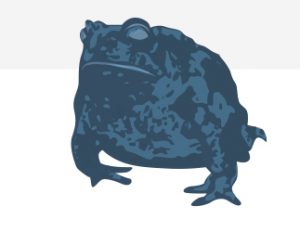Map of the Endangered Species Act
By Emilene Ostlind and Gary Beauvais
| INNER WORKINGS OF THE ESA
|
ESA SPECIES IN WYOMING
|
Petitioned
 Any member of the public can petition a species to be added to the threatened or endangered species list. Petitioning entails writing up a justification for why the species deserves protection and including information and supporting documentation that gives evidence of the need to list the species. Species can be petitioned repeatedly. The US Fish and Wildlife Service (USFWS) has 90 days to respond, but some species linger as petitioned well beyond the 90-day limit.
|
Sturgeon chub (Macrhybopsis gelida) Little brown myotis bat Tricolored bat Plains spotted skunk Regal fritillary Western bumblebee Yellow-banded bumblebee Monarch butterfly Narrow-foot hygrotus diving beetle Yellowstone bison For decades, groups have petitioned the bison for protection under the ESA. Each time, the USFWS has found the petitions “not substantial” or “not warranted.” That doesn’t stop petitioners from tweaking and resubmitting their pitches to protect the species. Most recently two environmental groups argued Yellowstone bison are different from other plains bison and are threatened by disease and “impairment of genetic and population structure due to ongoing management activities.” |
| Substantial
The USFWS looks at each petition to decide whether it provides “substantial information” that a listing may be needed.
|
|
| Not Substantial
If a petition doesn’t make a strong case for further investigation, the USFWS Not Warranted After further investigation, the USFWS may decide that the species is in good shape and protection is not warranted.
|
Over the last 20 years or so, more than 50 petitioned species that live in Wyoming have been found “not warranted.” On average, around two thirds of petitioned species are determined not to warrant the high level of protection provided by the ESA. Just last autumn, the USFWS determined three Wyoming species—the eastern subset of the western toad, the Black Hills black-backed woodpecker, the fisher, and the white-tailed prairie dog—were not in enough trouble to warrant listing. |
| Candidate (Warranted but Precluded)
|
Small rockcress (Boechera pusilla) Whitebark pine In 2011 the USFWS announced the whitebark pine warranted listing due to threats from blister rust and pine beetles, but other, higher priority species would be protected first. The tree has remained a candidate ever since. |
| Endangered or Threatened (Warranted)
Once a species is listed, there are all kinds of ways it is protected. It becomes illegal to kill or harm the species or damage its habitat (anywhere for animals, only on federal lands for plants). The USFWS often writes a recovery plan, which designates critical habitat, sets recovery goals for the species, and details recovery actions like captive breeding, reintroduction, monitoring, and more.
|
Endangered
Black-footed ferret Kendall Warm Springs dace Blowout penstemon Wyoming toad The Wyoming toad once teetered near extinction. Captive breeding and reintroduction to the wild is bringing it back. Threatened Canada lynx Northern long-eared myotis bat North American wolverine Preble’s meadow jumping mouse Colorado butterfly plant Ute ladies’ tresses Western glacier stonefly Desert yellowhead The desert yellowhead, which lives only in a few acres southeast of Riverton, Wyoming, was listed as a threatened species in 2004. |
| Extinct
|
|
| Taxonomic Revision/New Information Discovered
|
Although there have been no taxa listed and then delisted due to a taxonomic revision in Wyoming, the state has come close to this situation with some rare invertebrates. For example, the USFWS listed the Idaho springsnail as endangered in 1992. In 2004 three more species—the Jackson Lake (in Wyoming), Harney Lake, and Columbia springsnails—were petitioned for listing. Further investigation determined, however, that the four species are all the same and more widespread than previously thought. In 2007, the USFWS delisted the Idaho springsnail. |
| Recovered
|
Grizzly bear (Ursus arctos)
Gray wolf (Canis lupus) Peregrine falcon (Falco peregrinus) Bald eagle (Haliaeetus leucocephalus) With as fewer than 500 breeding pairs in the 1960s, the bald eagle was one of the first species listed under the ESA. Reduction of the pesticide DDT and other protections helped the species recover to nearly 10,000 breeding pairs by 2007, when it was delisted. |
Source: US Fish and Wildlife Service Environmental Conservation Online System, ecos.fws.gov. Numbers current as of November 2017.
Design by Jessica Perry/Creative Blue Yonder.


 deems it “not substantial” and meaning they won’t further consider the petition’s case any further.
deems it “not substantial” and meaning they won’t further consider the petition’s case any further. Some species deserve protection under the Endangered Species Act, but the USFWS just doesn’t have the time or money to protect them right now. Candidate species get a review every two years, and can hang in limbo for years or decades.
Some species deserve protection under the Endangered Species Act, but the USFWS just doesn’t have the time or money to protect them right now. Candidate species get a review every two years, and can hang in limbo for years or decades.
 If a species really is in serious trouble, the USFWS will first publish a “Proposal to List” in the Federal Register and open a 60-day public comment period.
If a species really is in serious trouble, the USFWS will first publish a “Proposal to List” in the Federal Register and open a 60-day public comment period.  Proposed species usually move to being actual listed species within a month or two. Endangered species are those in danger of extinction. Threatened species are likely to become in danger of extinction in the foreseeable future.
Proposed species usually move to being actual listed species within a month or two. Endangered species are those in danger of extinction. Threatened species are likely to become in danger of extinction in the foreseeable future.

 Though many more species have gone extinct through history, only 10 have been delisted because they went extinct, for example, the dusky seaside sparrow.
Though many more species have gone extinct through history, only 10 have been delisted because they went extinct, for example, the dusky seaside sparrow. Defining a species can be difficult. New genetic testing capabilities are revealing all kinds of things about species we never knew before. What were once thought to be unique species may turn out to be genetically identical to one another. In other cases, similar-looking organisms are found to be genetically distinct. Sometimes new information like this changes previous listing decisions, even leading to some species being delisted.
Defining a species can be difficult. New genetic testing capabilities are revealing all kinds of things about species we never knew before. What were once thought to be unique species may turn out to be genetically identical to one another. In other cases, similar-looking organisms are found to be genetically distinct. Sometimes new information like this changes previous listing decisions, even leading to some species being delisted. The whole point of the Endangered Species Act is to recover species that are in danger of extinction. Once a species reaches the numbers laid forth in its recovery plan, it can be petitioned for delisting. Recovery is evidence of the act’s success, and a testament to our nation’s ability to correct a wrong in the natural world. When a species is recovered and removed from the threatened and endangered species list, the USFWS continues to monitor it for a few years to make sure its numbers don’t plummet again, while management authority for the plant or animal returns to the state(s) in which it lives.
The whole point of the Endangered Species Act is to recover species that are in danger of extinction. Once a species reaches the numbers laid forth in its recovery plan, it can be petitioned for delisting. Recovery is evidence of the act’s success, and a testament to our nation’s ability to correct a wrong in the natural world. When a species is recovered and removed from the threatened and endangered species list, the USFWS continues to monitor it for a few years to make sure its numbers don’t plummet again, while management authority for the plant or animal returns to the state(s) in which it lives.

